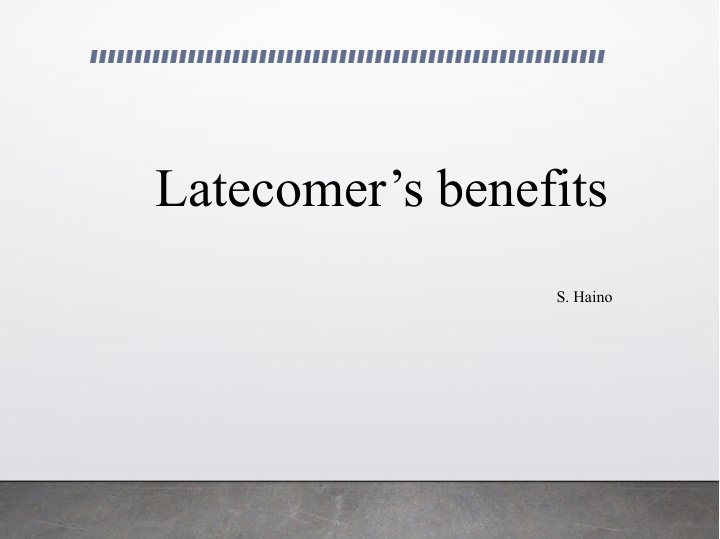



Latecomer’s benefits S. Haino
Latecomer’s benefits
Latecomer’s benefits → 後出しジャンケン
Current situation and foreseen scenario • O1: LIGO already detected 2(+1) BH-BH sources • O2: LIGO will detect x BH-BH (and maybe NS-NS/BH ?) Virgo will join for more accurate localization • O3: L-V will detect y BH-BH (and maybe NS-NS/BH ?) • KAGRA should join eventually but the sensitivities of L-V would be far advanced …
SH’s personal concerns and ideas • LIGO’s first GW detection marked the end of “GW search era” Now we entered a new era of GW physics/astronomy • Are BNS/BBH ranges the best performance indicator ? - Derived from integrating over wide frequency bands - In general, optimizing BNS/BBH range will make the sensitivities in high frequency worse • Can we tune the detector based on the physics targets ? - This is a standard approach in e.g. High Energy (HEP) projects
KAGRA will have a choice By the time KAGRA will join the GW network, we will see … Still BH-BH only or any NS-NS/BH detected ? or else … BH-BH only NS also Any sign of new GW sources ? No Any sign of new physics in BH-BH ? Any sign of EM counterparts ? Yes ! Yes: Focus on Any sign New physics in … ? Localization of HMNS ? Merger/ Inspiral QNM High frequency target Low frequency target Mid. frequency target
KAGRA’s technological advantages in low, mid. and high frequencies • [Low] Underground → Low seismic noise and enable 2-story tall suspension → Feasible to optimize the sensitivity at low frequency • [Mid./High] Cryogenic sapphire mirror → Low thermal noise, → High thermal conductivity, negligible thermal lensing • [High] Sapphire’s high young’s modulus → Less parametric instability → Better calibration accuracy (Pcal) However, because of the quantum limits, improving in both low and high frequency will need new challenges
Low frequency tuning • Team brown • Maximize KAGRA’s advantages - Underground → Low seismic noise and tall suspension - Cryogenic → Low thermal noise • Low laser power → Easy to keep the mirror cooled • Concerns: various noise sources
High frequency tuning • High power laser needed → Shorter and thicker mirror suspension needed → Increase suspension and thermal noise in low/mid frequency → Increase radiation pressure noise • Dominated by fundamental (quantum) noise • There are still KAGRA’s advantages - Cryogenic sapphire → Small thermal lensing, Parametric instability
Then G2.5 and G3 ? • LIGO → L+ → Voyager → CE • Virgo → V+ → ET • KAGRA → ?
Again KAGRA+ will have a choice in technological aspects By the time KAGRA is online, advanced technologies may have some developments/prospects on the feasibilities of : • 1.5~2um laser/silicon mirrors (concerns : ”soft” material and less-matured wavelength) • Heavier sapphire feasible ? • Frequency dependent squeezing achieved ? (e.g. Eleonora Capocasa et al. PRD 93, 082004 (2016) • High power laser (~500W input ?) • Low round-trip-loss (< 10 ppm) ETM coating feasible ? • Gravity Gradient Noise (GGN) canceling achieved ?
Just a few examples … Plot by Michimura-san Low freq. tuned Silicon LVK Heavy 500W laser Sapphire
Well… then what should we do ? Activate and keep the physics-driven discussions both inside and outside the collaboration • List-up possible physics breakthroughs and target frequencies • List-up current technical feasibilities and difficulties • List-up advanced technical feasibilities and difficulties • Listen to the voices from other GW projects and near-by communities
Conclusions Narrowband Win for the Brilliant physics !! Broadband Broadband
Recommend
More recommend